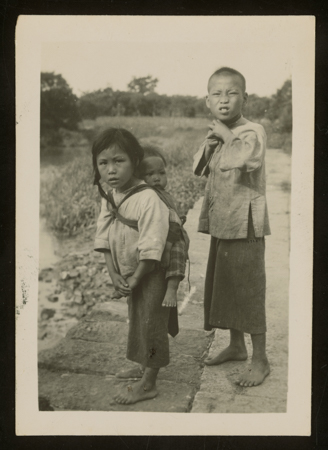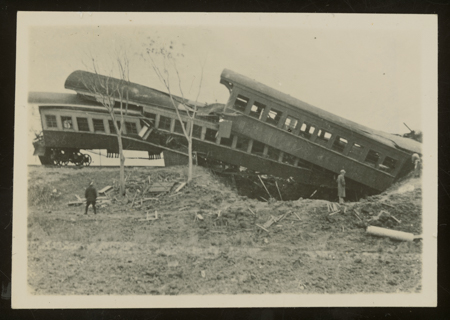April 2017
Welcome to the first edition of our new Presbyterian Archives e-newsletter.
In our first edition we begin on an Easter theme, and look at photographs from the Dunedin production of an Easter play in 2000.

With the approach of Anzac Day, and the continued commemoration of the centenary of the First World War, former Presbyterian Archivist, Yvonne Wilkie, introduces us to the Rev. James. Gibb of Wellington, who moved from a position of fervent patriotism at the start of the War, to one of ardent Pacifism, in response to the experiences of the young men of his congregation. In another war related story, we showcase some of the photographs from our Canton Villages Mission Collection which are currently on display in Toitu, Otago Settlers Museum in Dunedin. These photographs were taken by New Zealand Presbyterian Missionaries during the Japanese invasion of China just before the start of the Second World War, and tie in with the museum’s new film, “Journey to Lan Yuan”, which explores the story of the Chinese in New Zealand.
There is also an article of practical advice on what kinds of material your parish should send to the Archives.
The staff of the Presbyterian Archives would like to wish you all a blessed Easter,
Rachel Hurd
Archivist
“Sights and Sounds of Easter”
For centuries drama has been used as a way to present the Easter story. In the Middle Ages Passion Plays which enacted the Gospel story from Jesus entry into Jerusalem to his trial, death and resurrection, were very popular.Often they included elements of comedy to leaven out, but not detract from, the seriousness of the story. In a world where literacy was limited drama enabled ordinary people to encounter the Easter story in a way that conveyed it’s power and emotional depth.
At Easter 2000, three Dunedin congregations, Knox Church, First Church, and the Dunedin Chinese Church, (and possibly some members from other Dunedin congregations) joined together to produce their own modern version of a Passion Play, which was staged at Knox Church. Entitled “Sights and Sounds of Easter”, the script was adapted from an event which had previously been performed in the North Island.It was a performance that people journeyed through, and made use of the whole of the Knox Church and grounds.
The production was repeated again in 2002, though this time without the donkey (“not worth the trouble it caused”).
Does your church have a special event that you feel should be remembered? Send us photographs (either prints or digital) and we would be happy to add them to our collections.
Zealous Patriot to Ardent Pacifist
by Yvonne Wilkie

‘The life in the trenches is decidedly on the rough side but could be a good deal worse…we are now used to leaving the shave and wash. While actually in the trenches we do not sleep ’, wrote William Hopkirk from ANZAC, Gallipoli to his minister James Gibb, of St. John’s Wellington in November 1915. ‘At times snipers make us bob our heads & when the high explosives come over it is time to ‘duck’. A few of our fellows have already been hit. I am sorry to say some of them either killed immediately or fatally wounded. When things like that happen one begins to see the real meaning of war, though I understand that it is when an advance is in progress that the worst of the whole business appears.’ It was during such an advance that William Spottiswood Hopkirk’s short life of 24 years ended on 1 June 1916 in Armentieres, France. His last letter of April 1916 spoke of looking for signs of the end of war and would if he could ‘about double’ and make for New Zealand. He felt however that he must do his ‘little bit’ but God willing, ‘we will be back some day’.

Will, as he called himself, was one of the many committed St. John’s Bible Class men who exited the congregation to participate in a ‘war that would end all wars’. The Bible Class Roll of Honour has some 120 names and in August 1918, 61 members were on active service. The death of men who showed such promise as Will Hopkirk disturbed Gibb considerably and was a contribution to his ‘conversion’ from a ‘zealous patriot’ to an ardent pacifist.

Gibb’s ability to influence the war effort through his sermons, patriotic addresses to numerous organisations, magazines and newspapers led him to comment in the 1930’s that he ‘was as good as a recruiting agent during the war’. His militarist fervour was supported by many but there were those who did not let his comments and statements go unchallenged even from the service men he wrote to.
The correspondence that has survived from the soldiers reflects their individual doubts as to the outcome of the war as much as it does their sense of responsibility to fulfil the reason they were participants in the first place. Ian Gow questions the mysterious movements of God when to those at the centre of action the question was how could the ‘things they see everywhere possibly make for good’? Gow believed that war itself was a scourge which human beings brought upon themselves. ‘The mystery is too great for me’ he writes, ‘far from it being a purifier, the war merely burns the dross deeper into the national soul and so one asks, why should an all-loving God allow such a state of affairs?’

Gibb did not appear to directly respond to this reflection by one of his ‘boys’. But in a letter to W. Howard Johnson in July 1917, one year on from the death of Will Hopkirk, he gave some consideration to God’s intent. An outright victory did not appear a possibility for either side he surmised, and that maybe the intention of the Divine Providence: ‘to open the eyes of the nations to the fact that war was not only a crime but an insanity.’ This is in sharp contrast to his jingoism of mid-1916 when Gibb could say ‘we are pledged to this conflict, to see that Germany’s insensate pride, … merciless cruelty … be brought reeling and crushing to the dust.’
By the end of the war he was appalled at the lose of so many good men and the list of wounded published made ‘doleful reading’. The long list of wounded and those who lost their lives from St. John’s grieved him greatly. He noted to a critic that his hope and prayer would be for the human conscience to be aroused to recognise that modern warfare led ‘to waste and woe and horror multiplied upon horror.’

Gibb slowly came out so to speak and publicly declared his abhorrence for war and from the 1920s on established a League of Nations group within the Church and was President of the New Zealand branch. He spoke out against compulsory territorial training and conscription, supported the peace movement and was an advocate for disarmament. He challenged the Church in 1935 to take a stand against war. If the church refuses he wrote, ‘men will leave the Church in order to be Christians.’
The Rev. Dr. James Gibb died on 24 October 1935. Five years on the Church he so loved would once again be praying for victory in war.

The Journey to Lan Yuan
Since January, photographs from the Presbyterian Research Centre have been exhibited at Toitu Otago Settler’s Museum in Dunedin, in association with the museum’s new film, “The Journey to Lan Yuan”. This film looks at the history of the New Zealand Chinese community, and particularly those Chinese settlers who came from the area around Guangzhou [Canton].
The photographs on display were taken by Presbyterian missionaries from the New Zealand Canton Villages Mission, and show the local effects of bombing by the Japanese during their invasion of China in the late 1930s, including damage to the Mission Hospital at Kong Chuen.
These photographs provide a unique perspective on the experience of this conflict, and the experiences of the local Chinese people, many of whom had family in New Zealand.
Records, Records, Records…
Do you have parish records taking up space in your parish office? Are they lurking in the garage or in boxes under the spare bed? Don’t put them in the recycling or heave them into the skip. Send them to us at the Presbyterian Research Centre (Archives) at Knox College, Dunedin. We would love to receive your records, and give them the care and attention that they need as a record of the faith journey of your parish.
“But there’s so much here” people often say. “How do we know what to send to the Archives?”
Don’t despair! Here is a quick list of the kind of material that needs to come to Archives.

1. Marriage and Baptism Registers
These are a great resource for people wanting to find out about their family history.We would also like you to keep registers of communicants, and any burial registers (if kept).
2. Minute Books
You need to keep the Minute Books for both the Kirk Session and the Board of Managers (and Parish Councils). These tell the story of your parish. Please also keep all official correspondence.
3. Plans
Any plans of your church or other associated buildings, along with deeds, titles, mortgage records,and any other documents or correspondence relating to the buildings.
4. Photographs
A picture tells a thousand words…Photographs bring the people and events of your parish vividly to life. We would greatly appreciate any information about who is in the photographs, and what is happening.
5. Financial Records
These help to flesh out your story, but we don’t need to have all of your bank records (they take up heaps of space!). Please hold onto them yourselves for seven years to meet IRD requirements.

6. Records of Women’s Organisations
This includes records for the APW, PWMU, Ladies’ Guilds and Women’s Fellowship. Women have always played a vital role in the life of the Church.
7. Records of Groups for Children and Young People
Do you have Cradle Rolls or records for Sunday School, Busy Bees, Bible Class, Youth Groups, Boys and Girls Brigades, or Scouts? What about Messy Church? We would love to see any of these!

8. Records of Other Church Affiliated Groups
This can include records of sports teams, literary societies, craft groups, choirs and other music groups, temperance organisations, and groups associated with social justice or community support. Whatever your church community has done, we want to know about it.
9. Newsletters
These illuminate the day to day life of your parish.
Want to know more?
A fuller description of what records to keep (and how to look after them if you retain your own collection) can be found on our website at;
Click to access whatarewetokeep.pdf
Alternatively you can email us at pcanzarchives@prcknox.org.nz
or phone (03) 473 0777.










